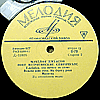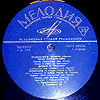From the middle sixties to late eighties 99% of Russian vinyl records were issued on
Melodiya label. I have seen occasional records on Akkord label, probably more of them existed but too few to be considered.
First it should be mentioned that from early 60-ies to mid 70-ies not all records had their "personal" picture sleeves. 7", 10" and even 12" records were housed in standard Melodiya factory sleeves. Personal sleeves are found only on few sixties LP's. And even by the mid-eighties there were LP's in such factory sleeves. Soviet economy was a strange thing... So don't be confused when offered a Russian 1980 pressing LP in factory sleeve - it's OK. Some records (both 7" and LP's) had never got their own, picture sleeves.
Determining the year and pressing
Below please find a table of Melodiya catalog numbers for LP's. After each year you'll see the first MONO LP issued this year and first STEREO LP issued this year.
| year | MONO | STEREO | | year | MONO | STEREO |
| 1961 | 9965 | 101 | | 1977 | 39551 | 8267 |
| 1962 | 10927 | 235 | | 1978 | 40507 | 9901 |
| 1963 | 12246 | 473 | | 1979 | 41387 | 11593 |
| 1964 | 13149 | 793 | | 1980 | 42279 | 13333 |
| 1965 | 14939 | 911 | | 1981 | 43015 | 15231 |
| 1966 | 16093 | 1161 | | 1982 | 43923 | 17003 |
| 1967 | 19069 | 1411 | | 1983 | 44813 | 18983 |
| 1968 | 21253 | 1629 | | 1984 | 45689 | 20729 |
| 1969 | 24023 | 1663 | | 1985 | 46081 | 21293 |
| 1970 | 27047 | 1865 | | 1986 | 46621 | 22915 |
| 1971 | 29491 | 2417 | | 1987 | 47417 | 24301 |
| 1972 | 31565 | 3057 | | 1988 | 48023 | 26129 |
| 1973 | 33489 | 3755 | | 1989 | 48477 | 27787 |
| 1974 | 35207 | 4593 | | 1990 | 48971 | 29059 |
| 1975 | 36849 | 4593 | | 1991 | 49417 | 31759 |
| 1976 | 38213 | 6607 | | | | |
|
This table lets you determine exactly when was a particular album
issued (NOT PRESSED!) - please keep in mind that usually LP's reissues had original numbers (see above). A few more clues may help you to find out if your record is a first pressing or a re-issue:
These clues are:
- manufacturing standard (
 ) with 6 digits placed on the label near the spindle hole. Throughout 1961 to early 1969 Melodiya records had ÃÎÑÒ 5289-61
) with 6 digits placed on the label near the spindle hole. Throughout 1961 to early 1969 Melodiya records had ÃÎÑÒ 5289-61
Throughout 1969 to early 1974 Melodiya records had ÃÎÑÒ 5289-68
Throughout 1974 to early 1980 Melodiya records had ÃÎÑÒ 5289-73
Throughout 1980 to early 1989 Melodiya records had ÃÎÑÒ 5289-80
From 1989 and on Melodiya records had ÃÎÑÒ 5289-88
- label color
- label design.
Here's the overview of Melodiya labels:
CLICK IMAGES TO ENLARGE
1961-68
There's ÃÎÑÒ 5289-68 on label, label color is yellow, black or dark blue (some earlier - white or multicolored)
|
 
|
late 1968 - 71
Label color is yellow, black or dark blue, there's ÃÎÑÒ 5289-68 on label and the word MELODIA is written in an "OUTLINE" or CONTOUR style on the l
|
 
|
1971-73
Label color is yellow, black or dark blue, there's ÃÎÑÒ 5289-68 on label and the word MELODIA is written in "SOLID" or BOLD style on the label (see picture). Last detail is very important - only by this you may tell a 1969 pressing from a 1972 pressing.
|

|
1974-79
There's ÃÎÑÒ 5289-73 on label, Label color is yellow, black or dark blue. PINK, WHITE and RED labels were added around 1974-75.
|
 
1974-79 1974-79
|
1980-88
There's ÃÎÑÒ 5289-80 on label. Labels are white or red (a few - pink). Around 1982 Melodiya changed its label style - see pictures.
|
 
1980-82 1982-88
|
1988-94
There's ÃÎÑÒ 5289-88 on label. Labels are white or red. Different record plants used different label designs.
|

|
Pressing plants
In the USSR there were several record plants. Records' labels are slightly different for these plants although all the rules mentioned above are true. It's curious that often record plants used different sleeve artwork versions for the same album.
- Aprelevsky plant (Moscow)
- Leningradsky plant (Leningrad)
- Riga plant (Riga, Latvia)
- Opytny plant "Gramzapis'" (test plant - Moscow)
- Tashkent plant (Tashkent, Uzbekistan)
- Tbilisi plant (Tbilisi, Georgia)
- Leningrad, Moscow and Riga
pressings are most common and Tbilisi pressings are
the rarest.
IMPORTANT STATEMENT. All the information above (except for the table) was gathered and brought to a system by me. There surely may be mistakes and exceptions. Nobody's perfect…
Other record labels
In late eighties when Perestroika in the USSR was running new record labels began to appear. Presented here are the most significant ones.
Antrop (
often misspelled as Anfon due to the stylized emblem placed on the sleeves)
Was founded by
ANdrey
TROPillo. The one great Tropillo who is responsible for producing the greatest Russian underground albums by Aquarium, Kino, Zoopark, Televizor to name a few. He started his vinyl business with semi-legal and absolutely illegal pressing of western rock classics beginning with the Beatles. Antrop also issued some great Russian rock music, most of which was recorded by Tropillo himself .
Around 1993 Tropillo used the SANTA label (numbering the same as ANTROP) and some LP's were "no label" - complete pirate pressings but again having the same numbering beginning with ATR or RAT.
SNC
Second significant label - SNC records was founded by Stas Namin, the leader of the band Tcvety (Flowers) that was very successful in the seventies. Among SNC releases I can mention best albums of Uriah Heep, Black Sabbath, some Aquarium, DDT and Kalinov Most.
Worth mentioning are also the following 90-ies labels:
COBWEB, RUSSIAN DISK, RITONIS, SINTEZ, FEE LEE.
TO BE CONTINUED...